
Mortellaro's Nursery
Shrubs, trees, ground covers, native plants, and seasonal color
Wholesale Only
Click on any of the alpha indexes below to view the corresponding lists of plants.
The default list is displayed alphabetically by common name for all plant types. You can view the plants by clicking on the Scientific Name or limit the plant type by using the drop down.
Plants actively being grown for the current season are shown -- selecting Discontinued Items will show plants we have offered in the past.
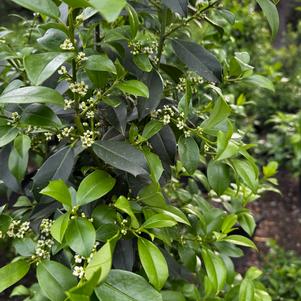
|
Eagleston HollyBotanical Name: Ilex x attenuata 'Eagleston'
Eagleston Holly (Ilex × attenuata 'Eagleston') is a hybrid evergreen holly tree known for its dense growth, pyramidal shape, and vibrant red berries in the fall and winter. A cross between American holly and Dahoon holly, Eagleston combines the best traits of both, offering year-round structure and seasonal interest. It is often used as a screening tree, formal specimen, or accent tree in residential and commercial landscapes. This holly performs best in full sun to partial shade and prefers well-drained, slightly acidic to neutral soil, though it is adaptable to alkaline conditions. Eagleston Holly is moderately drought-tolerant once established, and while not commonly browsed by deer, very young plants may require protection. As with most hollies, the female plants produce berries only if a male holly is nearby for pollination—however, most Eagleston trees available for sale are self-fertile. It typically grows to a mature height of 20 to 30 feet and spreads 10 to 15 feet, making it ideal for privacy hedges, windbreaks, or corner specimens. When used as a hedge, space trees 8 to 12 feet apart. Its dense branching and gray-green leaves provide strong visual appeal even outside the berry season, and light pruning can enhance shape and density. In USDA Zones 7–9, Eagleston Holly is cold hardy and performs well throughout most of Texas, though protection from drying winter winds is beneficial for young trees. It responds well to light shaping in winter or early spring, and mulching helps retain moisture and protect shallow roots during extremes. [ More Info ]
|
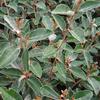
|
Elaeagnus or SilverberyBotanical Name: Elaeagnus pungens
The Elaeagnus, known to some as Silverberry, is a versatile and durable shrub well-suited for Texas landscapes. With its silvery-green foliage and dense, sprawling growth, Elaeagnus provides excellent privacy as a hedge or windbreak. It thrives in full sun to partial shade and is remarkably adaptable to a range of soil types, including sandy, loamy, or clay soils. Its drought tolerance makes it a valuable choice for water-conscious landscaping, particularly in the arid and semi-arid regions of Texas. Additionally, the plant produces small, fragrant flowers and fruit that attract pollinators and birds, enhancing biodiversity in the garden. Elaeagnus has a reputation for being deer-resistant, making it a reliable option in areas where deer browsing is a concern. Its drought tolerance is another significant advantage, as it requires minimal supplemental watering once established, aligning with xeriscaping principles. However, while it can tolerate a range of soil pH levels, Elaeagnus prefers slightly alkaline to neutral soils, which are common in many parts of Texas. This adaptability allows it to thrive in challenging conditions, including high heat and poor soil fertility. Despite its many benefits, Elaeagnus has some drawbacks to consider. Its vigorous growth can make it difficult to control, requiring regular pruning to prevent it from becoming overgrown. Additionally, it may be prone to invasiveness in some areas due to its rapid spread and hardiness. Gardeners should also watch for fungal diseases or root rot in poorly drained soils, as this can stress the plant. Nevertheless, with proper care and thoughtful placement, Elaeagnus can be a resilient and attractive addition to a Texas landscape. [ More Info ]
|

|
Elephant EarBotanical Name: Colocasia esculenta 'Black Magic'
Fast growing herbaceous perennial with heart-shaped leaves reaching up to 2-3 feet in length and 1-2 feet in width. Grows fine in standing water or poorly drained soils; responds very well to regular fertilization. Requires more water if grown in full sun. A gorgeous ornamental with many cultivars available on the market. 'Black Magic' cultivar has purplish-black leaves that turn a dullish green in the heat of the summer. Colocasia dies back in colder climates and will return if the corms do not dry out. [ More Info ]
|

|
Elephant EarBotanical Name: Alocasia sp.
Alocasia, often referred to as Elephant Ear, is a striking tropical plant grown for its large, upright, arrowhead-shaped leaves and bold architectural presence. Though the name “elephant ear” is often applied to several genera, Alocasia differs distinctly from Colocasia: its leaves stand upright or outward and are usually thicker, glossier, and more deeply veined. The point of attachment to the leaf is not central, creating a more angular, shield-like appearance. In contrast, Colocasia typically has drooping, heart-shaped leaves that attach centrally and face downward. In the landscape, Alocasia is best used in shaded to part-shade areas or containers placed out of the afternoon sun. It performs well in rich, well-drained soil that stays evenly moist, but not soggy. Alocasia is less tolerant of wet soils and full sun than Colocasia, making it better suited for protected patios, north-facing beds, or under high tree canopies in Central and East Texas. Leaves can reach 2–3 feet long, with plants maturing between 3–6 feet tall, depending on variety. Space plants 3–4 feet apart if grown in ground beds. While cold-sensitive, Alocasia can be grown as a warm-season annual or overwintered indoors in containers. In USDA Zone 9 and warmer, some varieties may return from tubers with protection. In Central Texas, treat it as a tropical that needs to be dug up or brought indoors before frost. Fertilize monthly during the growing season for best leaf size and color. [ More Info ]
|
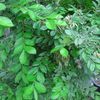
|
Elm, CedarBotanical Name: Ulmus crassifolia
Cedar Elm is a Texas native tree highly valued for its adaptability and resilience in the landscape. This deciduous tree is well-suited to a wide range of conditions across the state, including alkaline, rocky, and clay soils. It tolerates poor drainage and periods of drought, making it ideal for urban and rural settings alike. With its characteristic small, rough-textured leaves and graceful upright form, the Cedar Elm is a reliable choice for shade and ornamental use in Texas landscapes. Cedar Elm is particularly beneficial as a shade tree or a focal point in large yards or parks. Cedar Elm grows to a mature height of 50 to 70 feet with a spread of 40 to 60 feet, creating an expansive canopy. It thrives in full sun to partial shade and handles the intense Texas summer heat well. As a native species, it supports local wildlife, including birds and pollinators, and has natural deer resistance. Cedar Elm produces inconspicuous greenish flowers in late summer, followed by small, winged seeds in early fall. These seeds can create some litter but are a valuable food source for wildlife. When planting multiple Cedar Elms, space them 30 to 50 feet apart to allow their canopies to develop fully. In winter, Cedar Elm requires minimal care, as it is hardy across all of Texas and can withstand freezes without issue. Regular pruning during the dormant season helps maintain a strong structure and encourages healthy growth in the spring. [ More Info ]
|
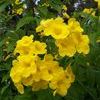
|
Esperanza, DwarfBotanical Name: Tecoma stans 'Gold Star'
Gold Star Esperanza is a standout cultivar of the Tecoma stans, admired for its compact form and prolific bloom production. This hardy, heat-tolerant shrub thrives in Texas landscapes, especially in areas with hot summers. Known for its vibrant yellow, trumpet-shaped flowers that bloom from spring through fall, Gold Star Esperanza adds a tropical flair to gardens and is a popular choice for pollinator-friendly plantings. While not a Texas native, this cultivar is widely used for its adaptability to various landscapes and its long flowering season. This sun-loving plant performs best in full sun, although it can tolerate partial shade with slightly reduced blooms. Gold Star Esperanza prefers well-drained soils and can handle neutral to slightly alkaline conditions. It is highly drought-tolerant once established, making it an excellent choice for xeriscaping. The plant is non-toxic, but its bright blooms can attract bees and other pollinators, so care should be taken when placing it in high-traffic areas. Deer tend to avoid it, adding to its appeal in rural or suburban settings. Gold Star Esperanza typically grows to a height and width of about 3 to 5 feet, making it more compact than the standard Tecoma stans. This smaller size makes it suitable for containers, small gardens, or as a mid-sized backdrop in larger plantings. When planting in the landscape, space plants about 3 to 4 feet apart to allow for airflow and proper growth. Regular deadheading of spent blooms can encourage continuous flowering throughout the growing season. In winter, Gold Star Esperanza is not as cold-hardy as the native species. In areas prone to freezing temperatures, it may die back to the ground but will regrow in the spring from its roots if well-mulched. In frost-free areas, it remains evergreen and blooms year-round with light pruning to shape and manage growth. [ More Info ]
|
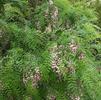
|
Eve's NecklaceBotanical Name: Styphnolobium affine
Eve's Necklace is a native Texas tree valued for its elegant appearance and adaptability to various landscape settings. This deciduous tree typically reaches a mature height of 15 to 25 feet, with a spread of 10 to 20 feet, making it well-suited for small to medium-sized landscapes. It thrives in well-drained soils and can tolerate both full sun and partial shade. In spring, it produces fragrant, wisteria-like clusters of pink flowers, followed by distinctive black seed pods that resemble a string of beads, giving the tree its common name. Eve's Necklace is particularly suited for use as an understory planting in wooded areas or as a specimen tree in more open spaces. Its moderate size allows it to thrive under the canopy of larger trees, where it provides a delicate contrast with its graceful form and colorful blooms. The tree is hardy in USDA Zones 7 through 9, making it suitable for much of Texas. While it is not specifically deer-resistant, its ornamental value and adaptability make it a good choice for many landscapes. However, caution should be taken as the seeds are considered poisonous, making it unsuitable for areas with children or pets. The tree is drought-tolerant once established, requiring minimal maintenance. When planting multiple trees, space them 10 to 15 feet apart to allow for their mature spread. Eve's Necklace is a great choice for adding texture and seasonal interest to Texas landscapes, with its unique blooms and striking seed pods. In winter, Eve's Necklace can generally withstand freezing conditions with minimal care. However, young trees may benefit from mulching around the base to protect the roots and retain moisture. Regular pruning during the dormant season helps maintain the tree’s shape and remove any damaged branches. [ More Info ]
|
